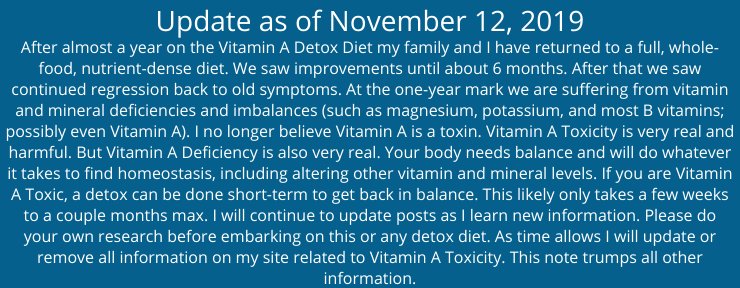 Have you ever wondered what all of the vitamins and minerals do you in your body? Or if they are really that important? Or that maybe we’re getting too much? What does Vitamin A do in the body? I’m sharing the details today.
Have you ever wondered what all of the vitamins and minerals do you in your body? Or if they are really that important? Or that maybe we’re getting too much? What does Vitamin A do in the body? I’m sharing the details today.

NOTE: I no longer support the Vitamin A as poison theory. All information in this article is purely to help you understand what it is based on. It is possible to get too much Vitamin A by overdosing supplements or liver. But that doesn’t happen often and can be quickly remedied if it does. Vitamin A from animal sources is an essential part of the diet. Beta Carotene can cause carotenemia (as my son had) but will not overload the body with Vitamin A. I encourage you to research and make your own decisions. You can read our update/why we turned and ran from the Vitamin A Detox Diet HERE.
Last week I presented the theory that Vitamin A is not really a vitamin at all. It is a toxin/poison.
Whether you are warming up to that idea or not, today I’m digging into the role of “Vitamin” A in the body. What does Vitamin A do in the body? What happens after you ingest it? And where does it go wrong?
I’ll admit, some of this stuff is a bit technical for me. It kind of makes my head hurt to read the details. But I’m going to do my best to break it down for you so you have a basic understanding. If you like the nitty gritty details make sure you read Grant Generuex’s books that I linked to in my previous post on Vitamin A. Most of the information in today’s post is what I learned from Grant’s book. But I tried to summarize it and break it down for you.
How Vitamin A is Supposed to be Handled
In a healthy (not toxic) person there is a simple cycle that the body uses to maintain balance when it comes to Vitamin A.
- Vitamin A is ingested.
- That Vitamin A is quickly transported to and stored in the liver.
- The stored Vitamin A is periodically called for by cells in the body when it is needed.
- The Vitamin A is delivered to its destination via Retinol Binding Protein (RBP).
RBP is like an envelope to deliver the retinol safely to its destination (this is a critical point). The body does not want to be exposed to retinol without RBP. Plain retinol is toxic. Also, the cells calling for retinol have receptors specifically for RBP. So the retinol goes directly where it’s needed in a nice protected package. A wonderful design.
Pretty straight forward. And harmless.

How Vitamin A is Handled in Toxic Individuals
But this simple cycle is messed up if the liver is saturated from excess Vitamin A. Now the tissue of the body is exposed to plain retinol without RBP because it is sitting around, not able to enter the liver. Instead excessive Vitamin A levels are now found in the blood serum, giving it time to combine with fat (remember it is fat-soluble). Other systems and organs try to deal with the excess vitamin A by storing it in the only safe wrapper it knows – fat. So that’s where it sits. And there is speculation that this is the cause of obesity! The body stores fat to handle excess Vitamin A.(you can read more about the connection of Vitamin A with obesity here).
So now the simple cycle above looks more like this:
- Vitamin A is ingested.
- That vitamin A is stored in adipose tissue (fat) because the liver can’t hold any more.
- Some of the retinol is converted to retinoic acid.
- Specific gene expressions (all my epigenetics fans – this is where it comes in) and immune response of the individual dictates how the body responds.
- This causes inflammation.
- Serum pH drops.
- Calcium is drawn from bones and teeth to compensate.
Not so simple now. The liver is swollen from excess Vitamin A (fatty liver). Organs and tissues are being exposed to retionic acid. And the body gradually breaks down little by little completely inflamed. In other words, you now have health problems like autoimmune disease. And you develop weak bones.
That is the big picture. Did you follow me?
Vitamin A at the Cell Level
There are two inflammatory responses in the body.
One helps heal. It is the body’s natural response to infection and injury. The immune system uses inflammation to protect against pathogens. In this case the inflammation is healing. You get sick…the body heats up and fights back. Wonderful.
The other is the body’s response to cell injury, damage or incorrect mutations. In this case inflammation is destroying. A damaged cell must be killed before it creates problems.
We all know that inflammation produces heat. This helps kill the pathogens/intruders. It is why you get a fever when you are sick. Your body is doing what it is supposed to do to fight and heal. And this is great when it really is a temporary invader (like infection or injury) or random cell damage. The body calls in the troops, heats up in battle and then settles down.
Inflammation and Autoimmune Disease
But that is not how it works with autoimmune disease. In this case the inflammation is chronic. But here is where current understanding goes wrong.
The inflammation itself is NOT the cause of the disease.
The inflammation is the body trying to do its job like always…but not succeeding because it is searching for phantom pathogens. So it is never-ending since it can’t actually find a pathogen. But there is no off switch. It is a search and destroy mission. And the heat applied to the retinol-containing lipids (fats) is like setting off a bunch of bombs!
The body is attacking a damage-associated molecule instead of a pathogen – your own tissue cells with the molecule. And all that heat it generates is what you know as an autoimmune flare-up.
The human body has quite a defense mechanism. It uses a lot of proteins and acids as weapons – one of which is retinoic acid. As the body produces more and more retinoic acid it creates more inflammation. As the retinoic acid destroys tissue (like skin, intestines and joints), it makes them very thin and weak (think eczema, Crohn’s and even leaky gut!). Ever heard of chemical peels for the skin? It’s retinoic acid!
After the acid attacks, the body quickly tries to make more tissue to compensate. But this time around the tissue is much thicker (sclerosis). This is how conditions like arthritis and psoriasis come about.
Where Does Retionic Acid Come From?
Obviously we don’t consume retinoic acid. So where is it coming from?
The Vitamin A we eat is retinol, retinal or its precursors carotenoids (like beta carotene). The conversion from Vitamin A to retinoic acid happens at both the cellular and molecular level. It is converted in the intestines and in other cells. Not damaged cells either. Retinol is metabolized to retinoic acid in normal cells.
I mentioned that the body knows how to transport retinol properly via RBP. Once it reaches its destination it is unwrapped and converted to retinoic acid (RA). The RA goes to the nucleus of the cell to be used for gene expression and protein generation. The gene expression can produce cytokines. Which in turn can produce an immune response. This is all well and good when the cell actually requested some retinol. It needs the retinoic acid for a specific purpose. And the liver is able to supply sufficient retinol for all the body’s needs.
Now here is where the real problem arises. When there is unbound retinol (excess retinol just floating around not packaged by RBP) it can still enter the cell. But the cell did not request it. The extra retinol has now bypassed the cell’s regulatory system. But it still produces cytokines and potentially more inflammation.
This is what we know as autoimmune disease. But it is not “auto.” There is a reason for it. Excess Vitamin A. The body does not just randomly produce inflammation. It is responding to something. And now we know what that is!
This conversion of retinol to retinoic acid will happen much more frequently in people with an over-saturated liver.
Too Much Vitamin A
Once your liver reaches saturation, the Vitamin A will be stored in other tissues – skin, fat and intestines. And disease begins. The body’s primary defense mechanism (liver) is out of commission. So any amount of Vitamin A you consume after that will cause problems (like a bathtub overflowing with water).
A little extra keeps the inflammation going. A lot extra makes a full blow autoimmune flare, burning holes in your skin, tissues and organs.
All Autoimmune Disease is the Same
Here’s where it all comes together. All autoimmune diseases are actually the same condition – Vitamin A Toxicity. Where the inflammation happens is unique to each individual based on genetics and lifestyle/diet. When the inflammation starts and how severe it gets just depends on how long it takes your liver to become saturated. It could happen at age two or age fifty.
I hope you followed all that! You may have to re-read it a few times for it to make sense. I know I did! That is the basic idea of what happens in the body when you consume Vitamin A. In small amounts it is totally fine. And probably necessary. God didn’t create it for no reason. But we have gone WAY beyond small amounts. And now we have so many sick individuals, including young children. It should not be common for kids to have diabetes, cancer, autoimmune disease and autism. But that is the reality of our world now. It has to stop!
The numerous conditions Vitamin A Toxicity can influence is beyond the scope of this post. Again, I refer you to Grant’s books (Poisoning for Profits and Extinguishing the Fires of Hell).
I am just scratching the surface of the Vitamin A Toxicity details in this post. But hopefully it’s enough to help you understand how Vitamin A can go wrong and make you curious enough to read more.
I hope you’ll stick around for next week’s post. The one I know everyone is waiting for…how to detox the Vitamin A and get help for your health problems! This is the key to getting your child to eat!!

Really interesting read. I didn’t know a lot of this info so thanks for sharing.
how much vitamin a is a proper amount to not experience toxicity?
There is no set amount as there are no good tests to tell you how much you have anyway. Right now we can only really go on symptoms. Really, we don’t need ANY Vitamin A. So even a moderate amount can be toxic.
I had 2 courses of accutane, now Microscopic colitis and food allergies, All myt ract disgest system is inflammed, can It be reversed? or is it too late, by the way I have hair loss, unable to gain weight. I am desperate
I have taken roaccutane had alot of stress in my life and worked with pesticides and had a normal audtralian diet and now i have acne rosacea on my forhead, cheeks and nose. Also have a host of other things like insomnia restless leg syndrome. Anxiety. Depression. Food intolerences and more. Now i know what caused it all. Vitamin A toxicity from the roaccutane. I was never the same after that drug i took 12 years ago. How long can vitamin A stay in the system and how can i detox it ? Please reply i need my life back
How long it takes to heal from Vitamin A Toxicity is different for everyone. And there is no good consensus on it. I personally think you can detox from it in 3-6 months. Try a low Vitamin A Diet for 3-6 months, see how you feel, and try adding foods back. If you still have tons of symptoms go a bit longer.
Is it lamb bone broth allowed?
I can’t remember if lamb is on the approved list. It’s not something we generally eat, so I didn’t pay attention.